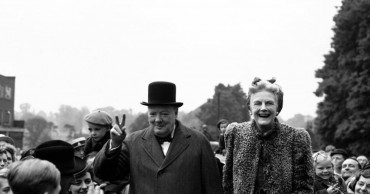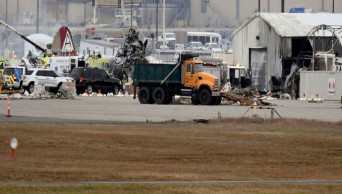World War II
Oppenheimer: 10 Fascinating Facts to Know Before Watching the Movie
The much-anticipated release of "Oppenheimer" took place on July 21, 2023. Directed by renowned filmmaker Christopher Nolan, the movie sheds light on the remarkable physicist Julius Robert Oppenheimer, famously known as the “Father of the Atomic Bomb”. This cinematic masterpiece promises to be a gripping and thought-provoking exploration of Oppenheimer's genius, his pivotal role in the Manhattan Project, and the profound moral dilemmas he faced during a critical juncture in human history. As you gear up to watch the film, let's explore some intriguing and lesser-known facts about the remarkable man behind the title.
Father of the Atomic Bomb
Julius Robert Oppenheimer, also known as the "Father of the Atomic Bomb," was a true wonder, a fifth element, who reshaped the course of history. Driven by an insatiable thirst for knowledge, a strong sense of social responsibility, and an unwavering dedication to scientific exploration, Oppenheimer left an indelible mark on the world, leaving us pondering the mysteries of the universe. Oppenheimer followed his curiosity wherever it led, leaving an indelible imprint on the 20th century. He is both the hero and the villain of his story, with a life transcending the boundaries of science and politics.
Interesting Facts to Know about the Physicist Oppenheimer Before You Watch the Movie
A Quintessential Historical Figure
Born on April 22, 1904, Oppenheimer emerged as one of the most influential figures in the world. In the words of Christopher Nolan: "Oppenheimer was the most important person who ever lived in human history." Such high praise from the esteemed filmmaker attests to Oppenheimer's profound impact on the world and the filmmaker. Nolan's film, "Oppenheimer," based on the book "American Prometheus," delves into the life of this enigmatic figure and the monumental Trinity test.
Read more: Top 12 South Indian Films Being Released in August 2023
A Film with a Subjective Narrative
"Oppenheimer," deemed Christopher Nolan's most ambitious film to date, revolves around the events leading up to the first atomic bomb test on July 6, 1945, seen through the eyes of Oppenheimer himself. Nolan and his team have emphasized the film's subjective narrative in interviews, aiming to offer a unique perspective on Oppenheimer's life. Therefore, exploring the critical events of Oppenheimer's journey can remarkably enrich your movie-watching experience.
Affinity for Sanskrit and Hinduism
The world associates the Holy Bhagavad Gita’s famous verse, “I am become death, the destroyer of worlds,” with Oppenheimer. After the successful detonation of the Trinity bomb, Oppenheimer found solace in these lines from the Gita, expressing his inner emotional turmoil. While not a devout follower of Hinduism, Oppenheimer often expressed deep admiration and reverence for Hinduism, its literature, and especially Sanskrit.
Oppenheimer's fascination with Sanskrit began during his undergraduate years at Harvard University, where he explored various languages, including Sanskrit. The language's ancient history, intricate grammar, and profound philosophical texts captivated him. His study of Sanskrit became a gateway for him to explore the philosophical depths of Hinduism. His affinity for Hindu philosophy extended beyond academia, encompassing various aspects like cosmic cycles, interconnectedness of all life, and the nature of existence.
Read more: Barbie ‘biggest film of 2023’ in US and Canada, Warner Bros says
2 years ago
World War II-era map sparks treasure hunt in Dutch village
A hand-drawn map with a red letter X purportedly showing the location of a buried stash of precious jewelry looted by Nazis from a blown-up bank vault has sparked a modern-day treasure hunt in a tiny Dutch village more than three quarters of a century later.
Wielding metal detectors, shovels and copies of the map on cellphones, prospectors have descended on Ommeren — population 715 — about 80 kilometers (50 miles) southeast of Amsterdam to try to dig up a potential World War II trove based on the drawing first published on Jan. 3.
“Yes, it is of course spectacular news that has enthralled the whole village," local resident Marco Roodveldt said. “But not only our village, also people who do not come from here.”
He said that “all kinds of people have been spontaneously digging in places where they think that treasure is buried — with a metal detector.”
It wasn’t immediately clear if authorities could claim the loot if it was found, or if a prospector could keep it.
Also Read: Missing World War II aircraft found in India after 77 years
So far, nobody has reported finding anything. The treasure hunt began this year when the Dutch National Archive published — as it does every January — thousands of documents for historians to pore over.
Most of them went largely unnoticed. But the map, which includes a sketch of a cross section of a country road and another with a red X at the base of one of three trees, was an unexpected viral hit that briefly shattered the mid-winter calm of Ommeren.
“We’re quite astonished about the story itself. But the attention it’s getting is as well,” National Archive researcher Annet Waalkens said as she carefully showed off the map.
Photos on social media in early January showed people digging holes more than a meter (three feet) deep, sometimes on private property, in the hope of unearthing a fortune.
Buren, the municipality Ommeren falls under, published a statement on its website pointing out that a ban on metal detection is in place for the municipality and warned that the area was a World War II front line.
“Searching there is dangerous because of possible unexploded bombs, land mines and shells,” the municipality said in a statement. “We advise against going to look for the Nazi treasure.”
The latest treasure hunters aren't the first to leave the village empty handed.
The story starts, Waalkens said, in the summer of 1944 in the Nazi-occupied city of Arnhem — made famous by the star-studded movie “A Bridge Too Far” — when a bomb hit a bank, pierced its vault and scattered its contents — including gold jewelry and cash — across the street.
German soldiers stationed nearby “pocket what they can get and they keep it in ammunition boxes,” Waalkens said. As World War II nears its end in 1945, the Netherlands' German occupiers were pushed back by Allied advances. The soldiers who had been in Arnhem found themselves in Ommeren and decided to bury the loot.
“Four ammunition boxes and then just some jewelry that was kept in handkerchiefs or even cash money folded in. And they buried it right there,” she said, citing an account by a German soldier who was interviewed after the war by Dutch military authorities in Berlin and who was responsible for the map. The archive doesn't know if the soldier is still alive and hasn't released his name, citing European Union privacy regulations.
Dutch authorities using the map and the soldier's account went hunting for the loot in 1947. The first time, the ground was frozen solid and they made no headway. When they went back after the thaw, they found nothing, Waalkens said.
After the unsuccesful attempts, the German soldier said “he believed that someone else has already excavated the treasure,” she added.
That detail was largely overlooked by treasure hunters who descended on Ommeren in the days after the map's publication. On a recent visit to the village, there were no diggers to be seen as peace and quiet has returned to Ommeren.
But the village's brief brush with fame left a sour taste for some residents. Ria van Tuil van Neerbos said she didn't believe in the treasure story, but understood why some did.
“If they hear something, they’ll head toward it," she said. "But I don’t think it’s good that they just dug into the ground and things like that.”
___
Mike Corder contributed to this report from The Hague.
2 years ago
Missing World War II aircraft found in India after 77 years
A missing World War II plane has been identified in India’s remote Himalayas nearly 80 years after it crashed with no survivors, following a search in a treacherous high-altitude area, reported Khaleej Times.
The C-46 transport aircraft was carrying 13 people from Kunming in southern China when it disappeared in stormy weather over a mountainous stretch of Arunachal Pradesh state in the first week of 1945.
“This aircraft was never heard from again. It simply disappeared,” said Clayton Kuhles, a US adventurer who led the mission after a request from the son of one of those on board the doomed flight.
The expedition saw Kuhles and a team of guides from the local Lisu ethnic group ford chest-deep rivers and camp in freezing temperatures at high altitudes.
Also read: Why investors fleeing Chinese property market see India as an opportunity
It was a potentially lethal mission: In 2018 three Lisu hunters had died of hypothermia in the same area when they were caught in an unseasonal September snowstorm, Kuhles said, while two others “barely escaped alive”.
“My Lisu guides and porters were very uneasy about our high camp location,” he added.
But the team finally located the plane on a snow-clad mountain top last month, where they were able to identify the wreckage by the tail number.
There were no human remains in what was left of the craft.
Kuhles was tasked with conducting the search by Bill Scherer, whose officer father was aboard the plane when it crashed.
“All I can say is that I am overjoyed, just knowing where he is. It is sad but joyous,” Scherer told AFP by email from New York.
Also read: India test-fires latest version of BrahMos supersonic cruise missile
“I grew up without a father. All I can think of is my poor mother, getting a telegram and finding out her husband is missing and she is left with me, a 13-month-old baby boy.”
Hundreds of US military planes went missing around the theatre of operations in India, China and Myanmar during World War II.
While hostile fire from Japanese forces did account for some aircraft losses, Kuhles said the majority are believed to have been brought down by ice damage, hurricane-force winds and other severe weather conditions.
3 years ago
Colin Powell: A trailblazing legacy, blotted by Iraq war
A child of working-class Jamaican immigrants in the Bronx, Colin Powell rose from neighborhood store clerk to warehouse floor-mopper to the highest echelons of the U.S. government. It was a trailblazing American Dream journey that won him international acclaim and trust.
It was that credibility he put on the line in 2003 when, appearing before the United Nations as secretary of state, he made the case for war against Iraq. When it turned out that the intelligence he cited was faulty and the Iraq War became a bloody, chaotic nightmare, Powell’s stellar reputation was damaged.
Still, it wasn’t destroyed. After leaving government, he became an elder statesman on the global stage and the founder of an organization aimed at helping young disadvantaged Americans. Republicans wanted him to run for president. After becoming disillusioned with his party, he ended up endorsing the last three Democratic presidential candidates, who welcomed his support.
For many Iraqis and others, Powell will forever be associated with that 2003 speech and the bloodshed that followed. But with Powell's death Monday at 84 of COVID-19 complications, Republicans and Democrats remembered him as a historic figure, a groundbreaking soldier-turned-statesman, the first Black secretary of state and first Black chairman of the Joint Chiefs of Staff.
Powell rejected comparisons between himself and previous icons like George Marshall, the World War II general who became America’s top diplomat. But he embraced a local-kid-does-good narrative that reflected his humble roots.
He was fond of recalling his youth in the Bronx, working first as a clerk in a neighborhood store and then as a sweeper in the massive Pepsi-Cola plant directly across the East River from the United Nations headquarters, a job he frequently referred to in meetings at the United Nations. A geology student at City College of New York, Powell made clear that he found his calling in the Reserve Officer Training Corps or ROTC, which would initiate his 35-year career in the Army.
Read:Colin Powell dies, exemplary general stained by Iraq claims
Powell served two tours in Vietnam and rose through the ranks with various stints in Cold War-era Europe before President Ronald Reagan tapped him as his national security adviser. President George H.W. Bush then appointed him chairman of the Joint Chiefs of Staff, where he oversaw the ouster of Saddam Hussein’s Iraq from Kuwait in 1991.
It was then that the “Powell Doctrine” emerged; it was a strategy for the use of American military power that relied on the deployment of overwhelming force and a clear and defined exit strategy from conflict.
Powell held the Joint Chiefs of Staff position into the Clinton administration, where he recalled arguments with Cabinet members over military intervention in the Balkans, which Powell believed was unwise.
“I thought I would have an aneurysm,” Powell wrote in a memoir about a White House incident in which then-U.S. Ambassador to the United Nations Madeleine Albright asked what good the armed forces are if they were never used. Powell ended up succeeding Albright as secretary of state in 2001.
And while his military career had taken him from the minefields of Vietnam to West Germany’s strategic Fulda Gap, it was his role as secretary of state in wartime that almost did him in.
Powell was the first of President George W. Bush’s Cabinet members to publicly blame Osama bin Laden for the Sept. 11, 2001 terrorist attacks and the first of Bush’s top national security aides to visit Pakistan, just a month later, to make clear to the Pakistanis that they must join the U.S.-led coalition or be labelled an enemy.
Amid significant security concerns in the aftermath of 9/11, Powell flew to Islamabad, his plane blacked-out as it went into a corkscrew landing to avoid potential rocket strikes, to tell then-Pakistani President Pervez Musharraf that his support in the operation to avenge the attacks was non-negotiable. It worked, at least in the short-term.
Powell was personally skeptical of the 2003 Iraq invasion and cautioned against the war privately. But he dutifully presented the administration’s case for invasion not only in diplomatic meetings with his counterparts but also in the now-infamous speech before the U.N. Security Council in February 2003.
Confronted with widespread doubts about the accuracy of the American and British assessment of Saddam’s capabilities and intentions, many compared the stakes of Powell’s speech to be similar to those of former United Nations Ambassador Adlai Stevenson’s electrifying 1962 presentation to the council about the Soviet Union’s placement of missiles in Cuba.
In Powell’s speech — which he would later call a “blot” on his record — he brandished a vial that he said could have contained anthrax that intelligence agencies insisted Saddam was producing in mass quantities.
“Less than a teaspoon of dry anthrax, a little bit — about this amount,” he told the council, waving the vial. “This is just about the amount of a teaspoon. Less than a teaspoonful of dry anthrax in an envelope shut down the United States Senate in the fall of 2001.”
Some, including several critics of the Bush administration, believed Powell had hit the mark, but unlike Stevenson 41 years earlier, whatever convincing he accomplished was quickly erased.
No anthrax or, in fact, any weapons of mass destruction were found in Iraq after the end of the war, which led to a protracted U.S. military occupation of the country that many believe resulted in a broader destabilization of the Middle East, including the rise of the Islamic State, that persists to this day.
While he will always be associated with the Iraq War, Powell was not an unaccomplished diplomat. He oversaw the resolution of the Bush administration's first foreign policy crisis, China's force down of a Navy spy plane and the detention of its crew, and self-deprecatingly referred to successes in resolving a spat with Moscow over a Russian ban on U.S. chicken imports and an armed dispute between Morocco and Spain over a small Mediterranean island.
Read:'Umblical cord': In Israel, Jaishankar hails contribution of Indian Jewish community
Powell was also critical in engineering an end to a standoff between Israel then Palestinian leader Yasser Arafat who had been blockaded in his Ramallah headquarters by Israeli troops during the second “intifada" or Palestinian uprising. And he was the first senior U.S. official to visit Afghanistan after the Taliban were ousted, flying into Kabul on a military plane in Jan. 2002, to meet with then-President Hamid Karzai.
Nonetheless, Powell’s biggest legacy at the State Department may be bureaucratic rather than diplomatic. A natural tinkerer who loved to collect and repair old Volvos and was a fan of the then-new Chrysler PT Cruiser, Powell pushed to bring the department’s antiquated computer and communications systems into the age of email and interoperability.
He fought budget battles to increase diplomatic spending and hiring and also led a successful drive to prevent the newly established Department of Homeland Security from entirely taking over the process of issuing visas, something that had been recommended in the wake of 9/11.
Unlike his predecessors and several successors as secretary of state, Powell was not enamored of foreign travel and spent less time overseas than almost any of America’s top diplomats since the dawn of the jet age, an aversion perhaps exacerbated by his unsuccessful behind-the-scenes attempts in Washington to blunt his Bush administration colleagues’ push for war with Iraq.
Personable and often approachable, Powell sought to assure his new employees that he would not be a burden on them in some of his first remarks to the diplomatic corps.
“I will be around to see you in due course,” he told his first town hall meeting. “I am an easy visitor. We are going to try to make it very easy for me to visit. Just to save a lot of cable traffic, I have no food preferences, no drink preferences. A cheeseburger will be fine. I like Holiday Inns, I have no illusions.”
4 years ago
Germany to give $662 million in aid to Holocaust survivors
Germany has agreed to provide more than a half billion euros to aid Holocaust survivors struggling under the burdens of the coronavirus pandemic, the organization that negotiates compensation with the German government said Wednesday.
5 years ago
Coronavirus batters Japan's economy
Japan’s economy saw the worst contraction on record when it shrank at an annual rate of 27.8 percent in April-June period as the coronavirus pandemic slammed consumption and trade, according to government data released Monday.
5 years ago
Britain faces most history-shaping election since WWII
Britain is facing the most testing and significant period in its modern history since World War II.
6 years ago
World War II-era bomber crashes; at least 7 reported dead
Windsor Locks, OCT 03 (AP) — A World War II-era plane with 13 people aboard crashed and burned at the Hartford airport after encountering mechanical trouble on takeoff Wednesday, killing seven of them.
6 years ago


.jpg)
.jpg)
.jpg)
.jpg)





